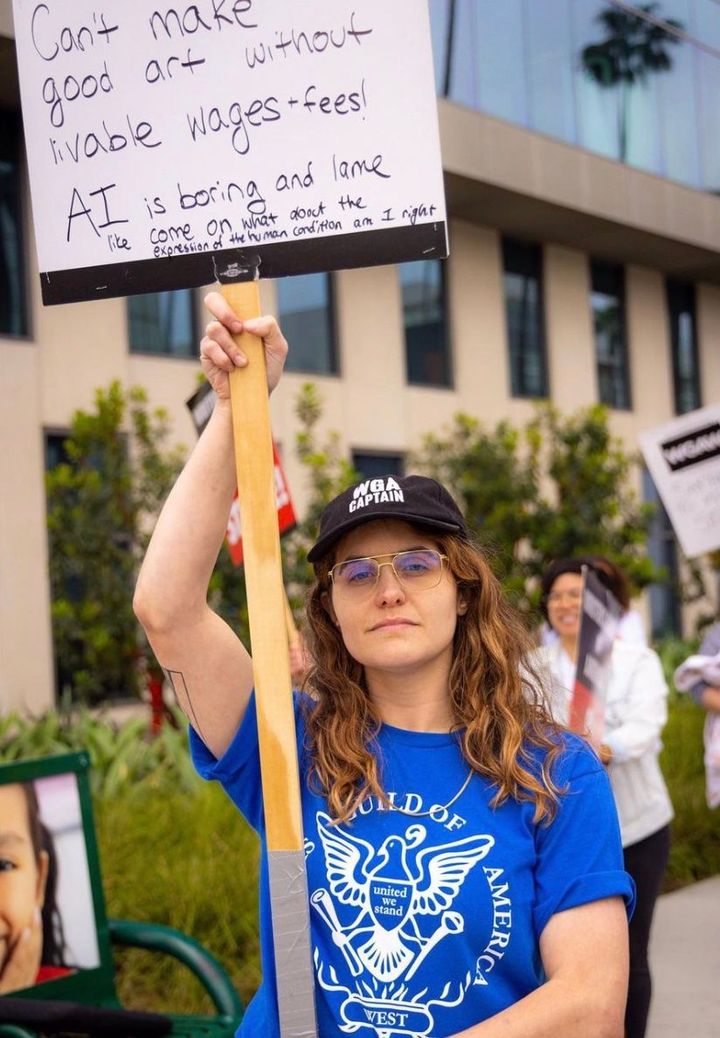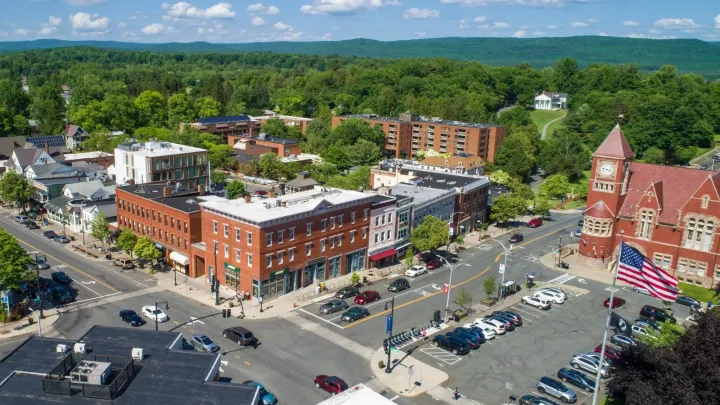Staff Spotlight: Kenny Lauzier
Staff writer Simon Pearl ’27 interviews Kenny Lauzier, Amherst’s Director of Auxiliary Services/Facilities. Among other responsibilities, Lauzier oversees Zamboni operations at Orr Rink.

Q: Can you tell me a bit about yourself and what led you to Amherst?
A: I grew up in Holyoke, Massachusetts, and attended the University of Massachusetts, Amherst. Like many young people entering college, it took me a while to figure out what I really wanted to do with my life and what I wanted to study. After redeclaring my major a handful of times, I found myself in the College of Natural Sciences studying plant, soil, and insect sciences. At that point in my life, I thought I really wanted to manage golf courses. I found after several years of pursuing such a career that I was beginning to think about golf, something I’d always loved, as work, and no longer as enjoyment. I felt it was time to make a change. A job came up at Amherst College, overseeing a small group of staff members that maintain the athletic facilities, including Orr Rink. Something about it felt right. I went for it and was ultimately successful. That was back in 2016. I learned quickly that I didn’t care about the “what” that I was managing so much. What I really care about is people. Since then, I’ve been fortunate to have been promoted within my department, and now find myself as the Director of Auxiliary Resources, overseeing landscape and grounds, waste management, vehicle maintenance, custodial services, and event support services. My job really has shifted significantly more toward managing people at this point. There are certainly parts of my first job at Amherst that I miss. One of those things is running the Zamboni at [the] Orr [Rink].
Q: What was it like growing up in Holyoke? Did you always know you wanted to live in the area?
A: Yeah, I think I had a very normal Western Mass upbringing. I think I always wanted to stick within the Western Massachusetts General area, just because that’s where a lot of my friends and family are. And I think that’s, you know, relatively normal. A lot of my friends and family went to U[niversity of] Mass[achusetts], Amherst. I think I always knew I wanted to go to UMass. I had an older brother who was six years older than me, and he also went to UMass. And so from a young age, I got to go to football games with him and see what the culture there was like, and I knew that was a culture that I wanted to engage with. I knew that was a part of my journey, my path, so I built even more relationships that tied me to the valley.
Q: Have you seen the Pioneer Valley change over time?
A: I think grow is just the word in general. Particularly growing up in Holyoke, I see a great deal of growth from the end of Alex Morris term as mayor and now transitioning to Josh Garcia’s terms as mayor: expansion of new businesses like Gateway City Arts in downtown Holyoke and the potential introduction of a massive sports complex in Holyoke. There’s talk of a 100 million-dollar sports complex combined with a new [International] Volleyball Hall of Fame. It’s very much so at the beginning stages of being in the works. But there’s absolutely a growth mindset, particularly as we talked about that southern section of the valley. And then I think this northern section of the valley, or this mid-northern section of the valley, where Amherst and UMass are, I think we’ve seen tremendous growth and expansion at the collegiate levels that have trickled into more small businesses, [bigger] population. And I think it’s always been the type of population that I’ve always wanted to be a part of. It’s a very diverse, accepting population, and it’s what I want for my family and my children.
Q: What drew you to your job here at Amherst?
A: Speaking honestly, I find myself very lucky to have wound up at Amherst College in the roles I’ve found myself in. I never imagined or dreamed I’d do what I do. I never thought to myself, “Yeah I’m gonna run a Zamboni someday.” It just sort of happened, and I couldn’t have been more fortunate.
Q: I’m wondering, what’s it like to drive a Zamboni? What are some things people may not realize?
A: I always joke when we’re training someone to operate our Zamboni, and I can tell that they’re intimidated, that if you can turn right, you can operate a Zamboni. This is obviously an oversimplification, but it’s an icebreaker that puts trainees at ease. From the stands, it probably looks like that’s all that’s happening on the ice. Someone is driving up and down the ice, turning right each time it appears that they’re going to drive straight into the boards where the nets once stood. But there’s much more that goes into it. When you’re “making ice” you’re doing a few things. You’re removing a layer of bad or imperfect ice that’s been beat up by folks skating on it, with a large blade. The blade scrapes up the old ice, and shoots it into a large tank at the front of the machine in the form of snow. The operator needs to be able to find that absolute perfect blade angle that’s going to make smooth ice, but also not remove so much that you get down to the concrete slab below the ice or overfill the tank, causing you to need to dump the snow before completing the resurfacing. While you’re scraping off this old layer, you’re laying a layer of water that will freeze into a perfectly smooth sheet of ice. One mistake many operators make is driving extremely slowly along the boards, out of a sense of being careful, and then really fast up the middle of the ice, out of a sense of wanting to complete the resurfacing in the 10 minutes we’re typically allotted between groups. But this means you’re laying uneven layers of water, creating a bowl shape in the ice. It’s minimal, but the players notice. Our goal is a perfect 1.25-inch layer of ice uniformly at all points. And there’s much, much more than the Zamboni that goes into effective ice maintenance. When you’re laying water down, it will actually creep up the boards and freeze in the form of ridges. On maintenance days, we go out with a motorized edger to smooth this out and ensure a perfect surface. We also use a method called crosscutting. Just like someone mowing their lawn in the same direction over and over will create imperfect patterns, an ice rink is no different. We will occasionally run the Zamboni in a cross-cutting pattern, that goes against these imperfections at a 90-degree angle and removes them, ensuring perfect ice.
Q: Are you and your team involved with the hockey team in other ways?
A: The team that maintains the rink often becomes relatively close with the team. During the winter months, they’re around each other quite frequently. So when the team makes a run at the playoffs, it’s exciting. You really feel like you’re a part of the team and a part of the action.
Q: Do you guys ever try to involve the crowd during the games?
A: Quite honestly, the team is too focused on the game to get involved with the crowd. In addition to maintaining the ice, the team is on standby should anything go wrong. Sometimes, a piece of glass might break during a game. It doesn’t happen all the time, but it happens more often than you’d probably imagine. The team needs to be prepared to remove the broken glass and install a new sheet at a moment’s notice.
Q: Is there anything else about your day-to-day working life that people may not expect?
A: The team that maintains the rink also maintains all the outdoor athletic facilities. This can be extremely challenging at a school like Amherst that is so competitive with its athletics. Each season bleeds into the next, and so you’re caring for fall and winter spaces simultaneously and then winter and spring spaces simultaneously. Nearly all of our teams have a chance of winning it all each season. As a result, they’re always going in multiple directions at the same time. It’s also very exciting because again, you feel like you’re part of the team and part of the program. So seeing these athletes succeed on the space that you prepared is extremely exciting.
Q: What are some of your favorite things to do outside of work?
A: I love spending time with my friends and family. I have an 18-month-old, first-time father. And I really enjoy golf in my spare time, which again is one of the reasons that I thought I would get into the world of managing golf courses. I love going to local restaurants, I love golfing. I love experiencing local culture.





Comments ()